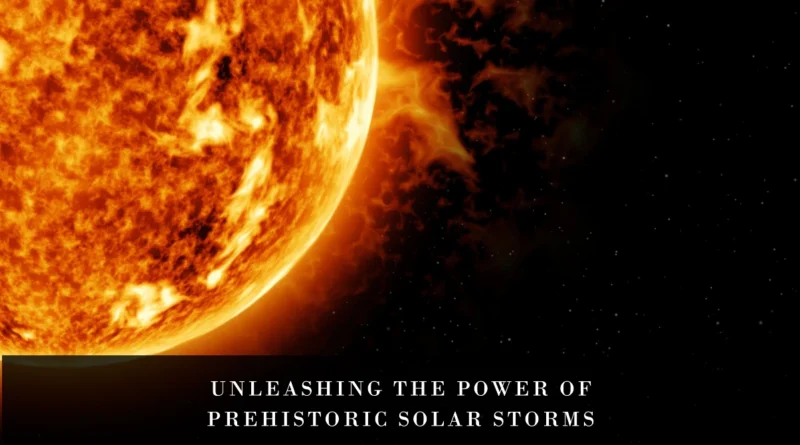Unveiling the Power of Prehistoric Solar Storms: Lessons and Preparations for Modern Earth
The sun, our constant celestial companion, is more than just a ball of light in the sky. It’s a dynamic powerhouse that occasionally releases explosive bursts of energy in the form of solar flares. These solar flares, while fascinating in their own right, can have significant implications for life on Earth, both historically and in the present day. In this blog, we’ll explore the intriguing world of solar flares, particularly a massive prehistoric solar storm that occurred around 14,300 years ago, and examine what it means for us today. To guide our exploration, we’ll organize the information into sections, complete with tables providing crucial insights.
The Power of Ancient Solar Storms
Solar flares, and eruptions of energy from the sun, are natural phenomena that have been occurring for billions of years. Our first table highlights key information about the massive prehistoric solar storm:
The 14,300-Year-Old Solar Storm
| Date of Event | Radiocarbon Levels | Impacts and Lessons |
| Approximately 14,300 years ago | Significant increase | Warns us about potential modern-day impacts on Earth’s technology. |
The prehistoric solar storm serves as a stark reminder that the sun’s power is not to be underestimated. While we may not have experienced such a colossal event in recent history, understanding its impact can help us prepare for future solar flares.
Impacts on Earth’s Technology
Solar flares can have profound effects on Earth’s technology and modern way of life. Let’s delve deeper into these impacts:
Impacts of Solar Flares on Earth’s Technology
| Impacts | Examples |
| Interference with communication systems | Disrupted radio signals and GPS |
| Disruption of power grids | Widespread blackouts |
| Challenges for space missions | Risk to satellites and spacecraft |
Solar flares have the potential to disrupt communication systems, create power grid problems, and even pose challenges for space missions. These impacts underline the importance of monitoring and understanding solar flares.
Modern Warnings and Preparedness
In this section, we will explore how we can detect solar flares and the warnings we have in place:
Modern Solar Flare Warnings
| Warning Time | Detection Methods | Preparation Measures |
| Up to 30 minutes | Advanced monitoring systems | Temporary shutdown of vulnerable systems, such as satellites and power grids |
Modern technology allows us to detect solar flares and provides a limited warning time of up to 30 minutes. During this time, we can take necessary precautions, such as temporarily shutting down vulnerable systems, to minimize potential damage.
Monitoring and Research
Continuous research and monitoring of the sun are crucial for understanding and predicting solar flares. Solar physicists and space agencies play a vital role in this ongoing effort.
Solar Flare Monitoring
Solar flares are typically monitored using advanced equipment such as solar telescopes and satellites. These instruments provide real-time data on solar activity, allowing scientists to detect flares as they happen.
Space Agencies’ Role
Space agencies like NASA are at the forefront of solar flare research. They employ cutting-edge technology to monitor the sun and issue warnings when necessary. For example, NASA provides vital information about the intensity and potential impacts of solar flares.
Research and Advancements
Scientists are continually researching solar flares to better understand their behavior. This research includes studying the sun’s magnetic field and the physics of solar flares. As our understanding of solar flares grows, so does our ability to predict and mitigate their effects.
Should We Worry About Solar Flares?
With all this information about the power of solar flares and our efforts to monitor and prepare for them, you might wonder if you should be concerned.
The short answer is yes, but not in a state of constant worry. Solar flares are a natural part of the sun’s behavior, and our technological advancements allow us to mitigate their impact to some extent.
However, it’s crucial to be aware of the potential risks and to stay informed about solar flare activity, especially if you live in regions where technological infrastructure is more susceptible to solar flare interference. Remember that space agencies and scientists are continuously working to improve our ability to predict and prepare for solar flares.
Conclusion
In conclusion, the massive prehistoric solar storm that occurred around 14,300 years ago serves as a powerful reminder of the sun’s capacity to impact life on Earth. Solar flares have the potential to disrupt our technology-dependent society, but with advanced monitoring, warning systems, and ongoing research, we can prepare and protect our modern way of life.
As we navigate the complex relationship between our planet and the sun, it’s essential to stay informed and appreciate the significance of solar flares. While we cannot control the sun’s behavior, our ability to predict and respond to solar flares is a testament to human innovation and resilience.
By understanding the power of prehistoric solar storms and the lessons they offer, we can better appreciate the incredible forces at play in our solar system and continue to adapt and thrive in the face of celestial challenges.




